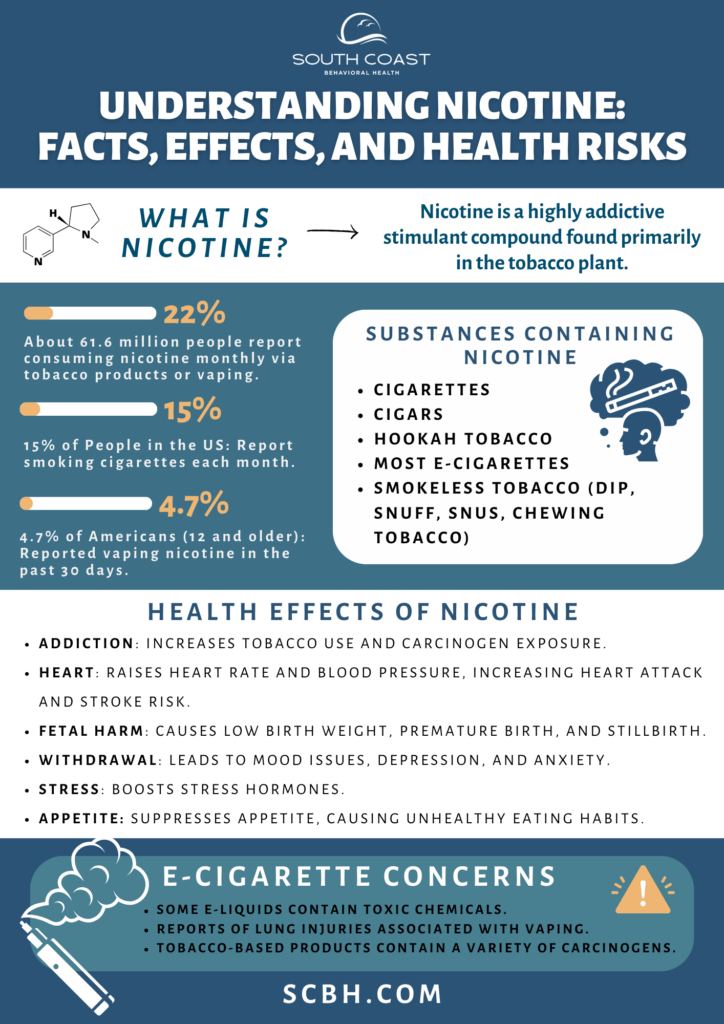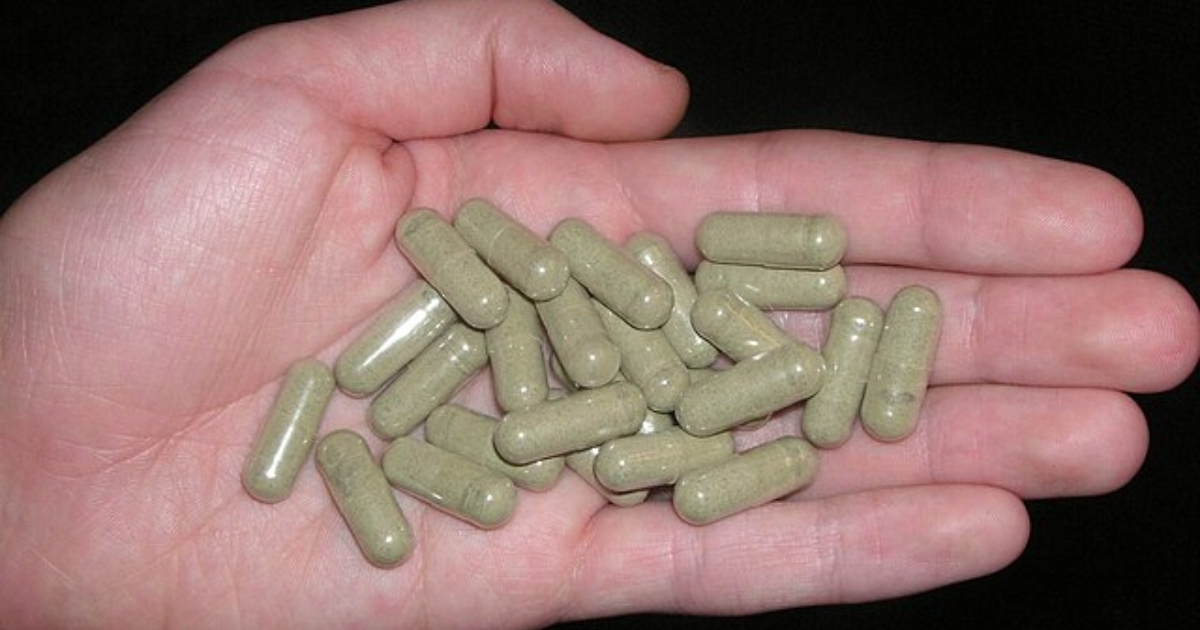The question of “how long does nicotine stay in your system” depends on method of consumption, as well as whether we are talking about how long nicotine, the active substance, is felt in your system, or whether we are talking about how many days out from use its metabolites can be detected on drug tests. This article will answer all that.
What Is Nicotine?
Nicotine is a highly addictive stimulant compound found primarily in the tobacco plant (Nicotiana tabacum). It can also be found in smaller amounts in nightshades. People typically use it for the pleasurable and calming feelings it produces in the brain. Over time, however, the brain starts to crave these feelings, leading to regular use and, for many, addiction.
People mainly consume nicotine in various tobacco-based products, but vaping has become increasingly popular.
Here are some quick nicotine facts:
- Per the National Institute on Drug Abuse, 22% of the US population (about 61.6 million people) report consuming nicotine in some form (whether via tobacco products or vaping) on a monthly basis.
- More than 15% of people in the US report smoking cigarettes each month, according to the Centers for Disease Control and Prevention.
- According to the 2023 National Survey on Drug Use and Health, among Americans 12 and older, 4.7% reported vaping nicotine in the past 30 days.
- Approximately 49 million Americans consuming nicotine in each year and 1.25 billion worldwide, according to the World Health Organization.
When it comes to how long does nicotine stay in your system, it’s important to note that it’s not just about the nicotine itself, but also its metabolite, cotinine. This remains in the body far longer than nicotine and thus is important to keep in mind when it comes to drug tests.
What Substances Contain Nicotine?
All tobacco products contain nicotine, including cigarettes, cigars, smokeless tobacco (such as dip, snuff, snus, and chewing tobacco), hookah tobacco, and most e-cigarettes.
How Much Nicotine Is in a Vape?
Standard vape levels are available in a variety of doses. Commercial vape juice is available in concentrations of 0 mg, 3 mg, 6 mg, 12 mg, and 18 mg per milliliter. For consumers with a higher tolerance level, high-dose cartridges with 24-36 milligrams per milliliter are also available.
How Much Nicotine Is in a Cigarette?
Each cigarette contains an average of about 10-15 mg of nicotine, but smokers absorb only about 1-2 mg of nicotine per cigarette.
Get confidential help from our addiction treatment specialists in Orange County. Call to join our rehab program today!
Call 866-881-1184Is Nicotine Bad for You?
While it’s not the primary cause of diseases associated with smoking (such as lung cancer, emphysema, or cardiovascular disease), nicotine does have various health effects on its own:
- Nicotine is highly addictive. Some have argued it is the most addictive drug. This addiction can lead to increased consumption of tobacco products, which exposes users to harmful carcinogens and other toxic compounds.
- Nicotine increases heart rate and blood pressure. Chronic exposure can contribute to the hardening of arterial walls, potentially increasing the risk of heart attack and stroke.
- There’s evidence that nicotine can harm fetal development, leading to low birth weight, premature birth, and stillbirth. Pregnant individuals are strongly advised to avoid nicotine.
- Nicotine withdrawal can cause mood disturbances, depression, and anxiety.
- Nicotine can increase the release of stress hormones.
- Some people use nicotine for its appetite-suppressing effects. This can lead to an unhealthy relationship with food.
- Because nicotine is a stimulant, it can disrupt sleep. The research on nicotine and sleep shows that prolonged nicotine use is linked to poor sleep quality, as well as sleep disorders.
- Some have argued nicotine is a gateway drug, and thus can open the door to usage of harder drugs down the line.
In addition, it should be noted that, while often marketed as a safer alternative to smoking, e-cigarettes introduce their own set of concerns. For instance, some e-liquids have been found to contain toxic chemicals, and there have been reports of lung injuries associated with vaping.
And, of course, any tobacco-based product will contain a variety of carcinogens, especially cigarettes. Cigars and pipes also contain carcinogens, albeit to a somewhat lesser extent than cigarettes, which contain many additives.
How Long Does Nicotine Stay in Your System?
The length of time nicotine and its metabolites such as cotinine stay in your system can depend on numerous factors, including the frequency of use, the amount used, individual metabolism, and the test used to detect it.
- Blood — Nicotine can usually be detected in the blood for one to three days after consuming tobacco or nicotine products. Cotinine can be detected in the blood for up to ten days.
- Urine — Nicotine itself may be detected in urine for up to three days, while cotinine can be detected for up to three weeks or longer, depending on factors like the individual’s metabolism, hydration level, and tobacco usage.
- Saliva — Nicotine may be detectable in saliva for up to four days.
- Hair — Hair testing can detect nicotine for up to one to three months after exposure. In some cases and especially with chronic exposure, it might be detectable for up to a year.
- Breath — Breath tests can detect nicotine for up to 24 hours after ingestion.
Remember, these are general estimates, and the actual detection time can vary based on multiple factors. Additionally, individuals who use tobacco or nicotine products regularly will likely have detectable levels for longer periods compared to occasional users.
If you’re trying to quit smoking or using nicotine products, consider reaching out to medical professionals or support groups for guidance and resources.
How Long Does Vape Nicotine Stay in Your System?
How Long Does Zyn Nicotine Stay in Your System?
Again, this is difficult to answer. Some people try to use nicotine pouches like Zyn to quit smoking, but because these products can be consumed anywhere, and are even more discrete than vapes, the inflow of nicotine into the body can be constant. Upon ceasing use, it will take one to three days for Zyn nicotine to leave your system and up to ten days for cotinine.
How to Clear Nicotine From Your System
The best way to do this is first and foremost to stop using nicotine.
Aside from that, you can support your body’s metabolic processes, such as to drink plenty of water, exercise a couple times week, and eat a healthy diet.

Looking for quality substance abuse treatment that’s also affordable? South Coast accepts most major insurance providers. Get a free insurance benefits check now.
Check Your CoverageAddiction Treatment at South Coast Behavioral Health
For those struggling with nicotine addiction, South Coast Behavioral Health offers compassionate and affordable addiction treatment.
The first step is going through a medical detox. Our medical detox program in California is staffed by caring and compassionate professionals who can provide you with medications to manage your withdrawal symptoms.
At South Coast, we take pride in offering care that is closely tailored to specific issues. To that end, we offer gender-specific detox programs, with medical detox for men in Irvine, CA, and medical detox for women in Huntington Beach, CA.
After detoxing, proper treatment can begin.
Treatment for substance abuse takes place along an entire spectrum of care. Along that entire spectrum are various behavioral therapies, support groups, and the use of medically-assisted treatment (MAT).
These levels of treatment are, in order, as follows:
Residential Treatment in California
After successfully completing medical detox, you’ll move to inpatient treatment in Orange County, California. There, you’ll receive medically-assisted treatment and dual diagnosis treatment to deal with any cravings or co-occurring mental health issues you may be battling. We also offer residential treatment facilities in Costa Mesa, Irvine, and Huntington Beach for those who desire gender-specific treatment. There, patients get round-the-clock medical attention and monitoring while living at our facility full-time.
In addition to individual and group counseling and medication management, you’ll also have access to leisure activities and family support services.
Partial Hospitalization in California
Most clients start substance abuse treatment with South Coast in our residential treatment program. After completing that, many desire something that still provides structure and support but with extra space and time to oneself. For that, we offer Partial Hospitalization in Newport Beach.
A step down from inpatient care but with more structure than conventional outpatient programs, partial hospitalization offers a good balance for those looking to ease back into normal life. Clients can receive care five to seven days a week for a number of hours each day, returning back to their sober living homes in the evening.
This way, they can recover without putting their daily lives completely on hold, receiving intense therapeutic interventions like group and individual therapy, skills development, and medication management as necessary.
Intensive Outpatient Treatment in California
For those leaving inpatient residential treatment or partial hospitalization, intensive outpatient programs (IOP) are yet another gradual step forward on the road to recovery.
With a focus on group therapy, individual counseling, and education, clients undergoing Intensive Outpatient Treatment in Newport Beach can meet three to five days a week. Each session lasts three hours.
This level of care requires the least amount of attendance at a facility. It’s also most likely the best option for treating nicotine addiction for most people, along with support groups.
Get Started Today
If you or a loved one are struggling with nicotine addiction but wonder how long addiction counseling takes or have other questions, call us at 866-881-1184 or contact us here. Our highly qualified staff will be happy to help give you an idea regarding how long does nicotine stay in your system, what to expect from your addiction recovery timeline, help verify your insurance, and assist with any other questions you may have.
- 2023 National Survey on Drug Use and Health (NSDUH) Releases | CBHSQ Data
- Tobacco Use – Health, United States
- What is the scope of tobacco, nicotine, and e-cigarette use in the United States? | National Institute on Drug Abuse (NIDA)
- E-cigarette, or Vaping Product, Use Associated Lung Injury (EVALI) > Fact Sheets > Yale Medicine
- Effects of Nicotine on the Central Nervous System and Sleep Quality in Relation to Other Stimulants: A Narrative Review – PMC
- Effects of Nicotine During Pregnancy: Human and Experimental Evidence – PMC
- Tobacco use declines despite tobacco industry efforts to jeopardize progress










